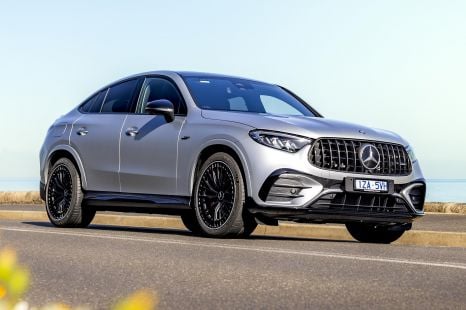

Marton Pettendy
2026 Mercedes-AMG GLC43 Carbon Edition brings more for less
3 Hours Ago
We look at the five cheapest cars in 1999 and 2024 to see just how much has changed and how much more you get for your money.

News Editor


News Editor
It seems like not only are the cheapest cars in Australia not so cheap anymore, but there are also far fewer options at this end of the market.
There are just two micro cars on sale in Australia, and five surviving light cars with a base price under $30,000.
Rewind 10 years ago to April 2014 and there were nine micro cars on sale and 19 light cars with a base price under $25,000.
But let’s go back even further, to a time where boy bands were big and people were worried about Y2K. Yes, it’s time to party like it’s 1999.

In April 1999, the cheapest car in Australia – the Daihatsu Sirion – was $11,990 before on-road costs.
According to the Reserve Bank of Australia’s inflation calculator, $11,990 in 1999 was worth in 2023 – the most recent year available – approximately $23,500. That’s actually more than the current cheapest car in Australia, which is $18,990 drive-away.
Whether wages have kept up with inflation is another matter is outside the scope of this article, as is the cost of living, but looking purely at vehicle prices you can see in 2024 there are still vehicles available for under $23,500.
Here are the five cheapest cars in Australia in April 2024.
Price: $18,990 drive-away
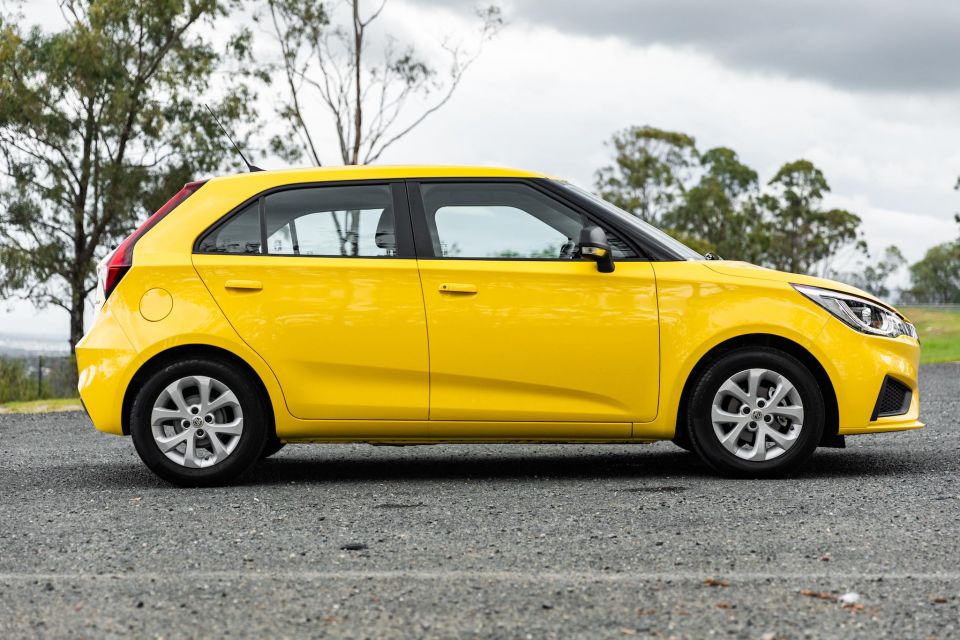
It’s Australia’s cheapest car again… for now.
After Kia’s recent Picanto facelift, which saw the Korean city car receive a significant upgrade in safety equipment but also a price rise, the MG 3 took back the crown.
With a recent price cut to $18,990 drive-away, the MG 3 has further cemented its role. With satellite navigation, its price climbs to $19,490 drive-away, while even the flagship Excite is priced at $19,990 drive-away.
Its role as Australia’s cheapest car will be short-lived. MG has said its next-generation MG 3, due here in July, will cost around $5000 more.
All MG 3 models feature a naturally aspirated 1.5-litre four-cylinder engine producing 82kW of power and 150Nm of torque, mated with a four-speed automatic transmission.
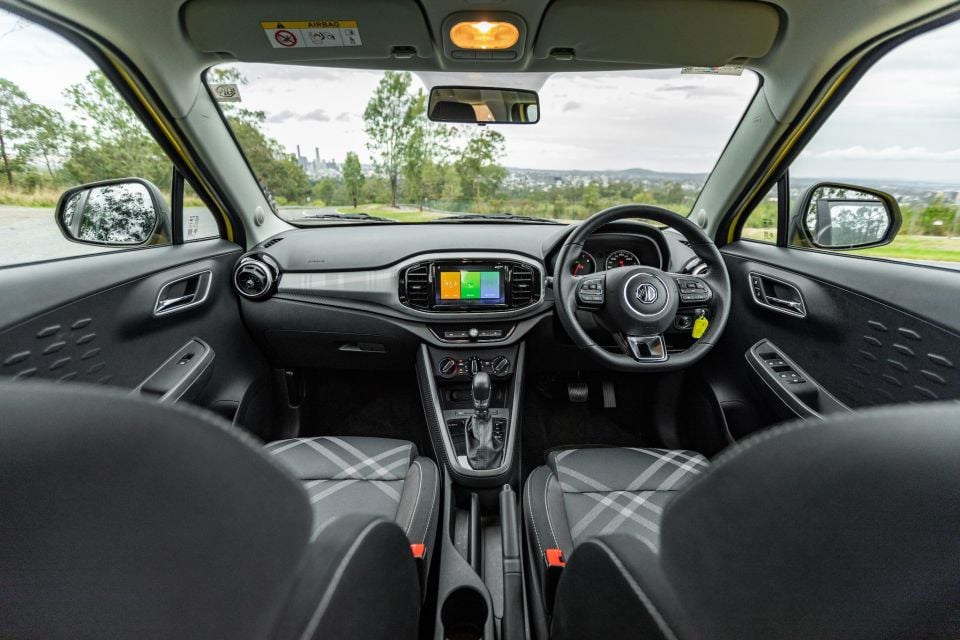
It uses 6.7L/100km on the combined cycle, and runs on 91 RON regular unleaded fuel.
There’s no standard autonomous emergency braking, but you do get other features that have become essentially universal (and in some cases mandatory) in the past 25 years in Australia, such as front, front-side and curtain airbags, anti-lock brakes, electronic stability control, a reversing camera and rear parking sensors.
Standard equipment across the range includes an 8.0-inch touchscreen infotainment system with Apple CarPlay, cruise control, remote control central locking, power windows and mirrors, a height-adjustable steering wheel and driver’s seat, air-conditioning, automatic headlights and tyre pressure monitoring.
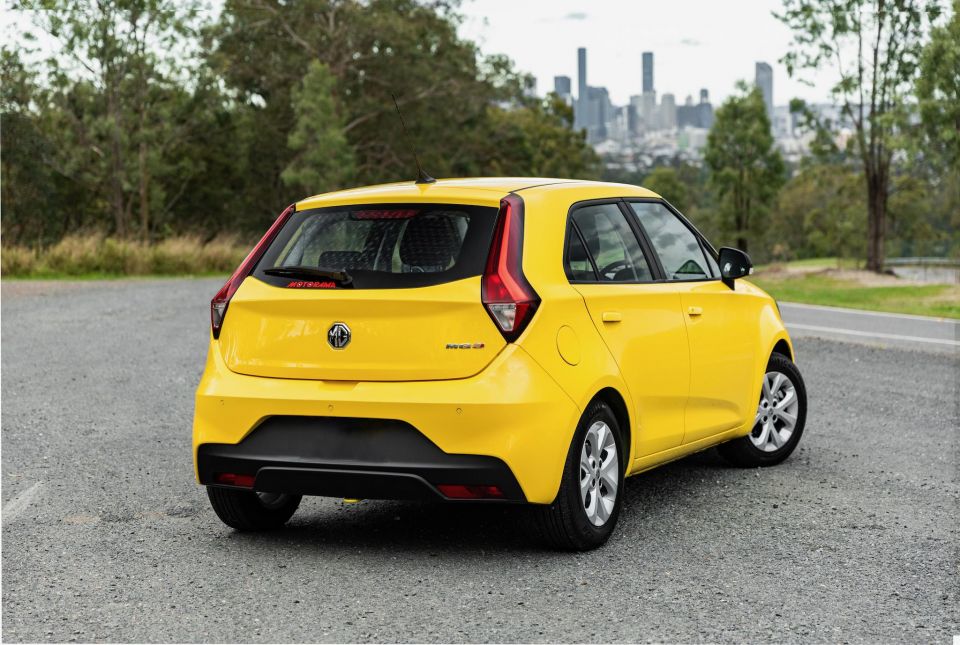
The Core gets a four-speaker sound system (instead of six like the Excite) and 15-inch alloy wheels instead of 16s, and misses out on satellite navigation.
All MG 3 models are backed by a seven-year, unlimited-kilometre warranty and come with seven years of capped-price servicing.
Intervals are every 12 months or 10,000km, with the first seven services capped at $251, $301, $292, $350, $251, $341 and $251.
MORE: Buy an MG 3 MORE: 2023 MG 3 review
Price: $17,890 before on-roads ($20,690 drive-away)

Members of the Picanto range take up a few of the spots in the top five cheapest cars list.
The Sport auto is $19,490 before on-roads ($21,690 drive-away), while the flagship GT-Line manual and auto are priced at $19,690 and $21,290 before on-roads ($22,490 and $23,490 drive-away) respectively.
The entire range therefore undercuts the next cheapest vehicles on this list, but where would be the fun of having just two nameplates on a list like this?
A mid-life update, launched last year, brought more standard safety equipment and bolder styling, but saw the turbocharged GT flagship axed.
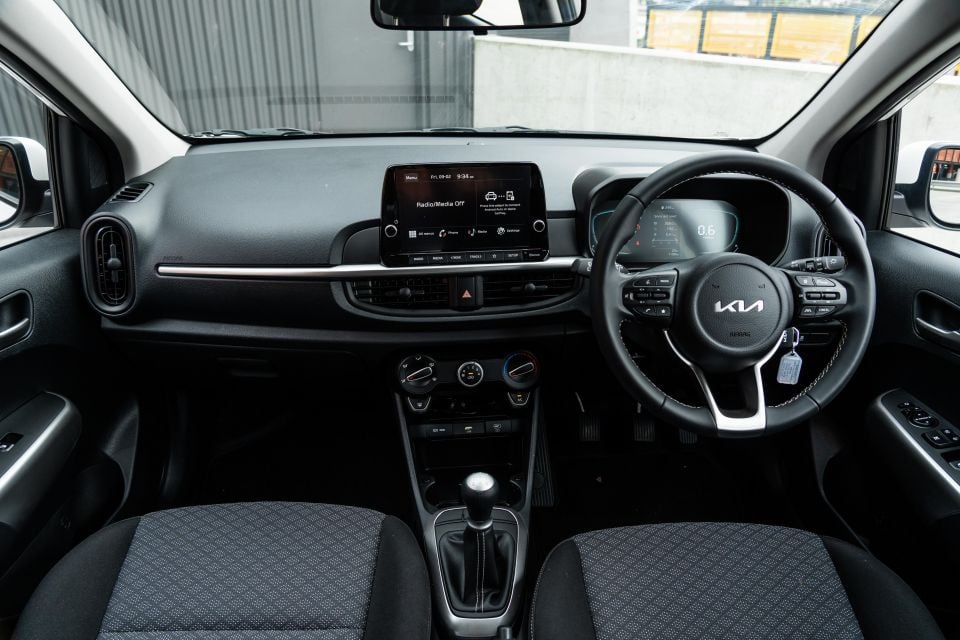
All Picantos, therefore, now come with a naturally aspirated 1.2-litre four-cylinder engine producing 62kW and 122Nm, mated with either a five-speed manual or four-speed automatic transmission.
Combined cycle fuel consumption is 5.4L/100km with the manual and 6.0L/100km with the auto, and the Picanto runs on 91 RON regular unleaded fuel.
All Picanto models come standard with autonomous emergency braking, lane-keep assist, Lane Following Assist (lane centring), a reversing camera and rear parking sensors.
They also come with blind-spot assist and rear cross-traffic assist, which will see the vehicle actively intervene to stop you from colliding with another vehicle instead of simply sounding an alert.
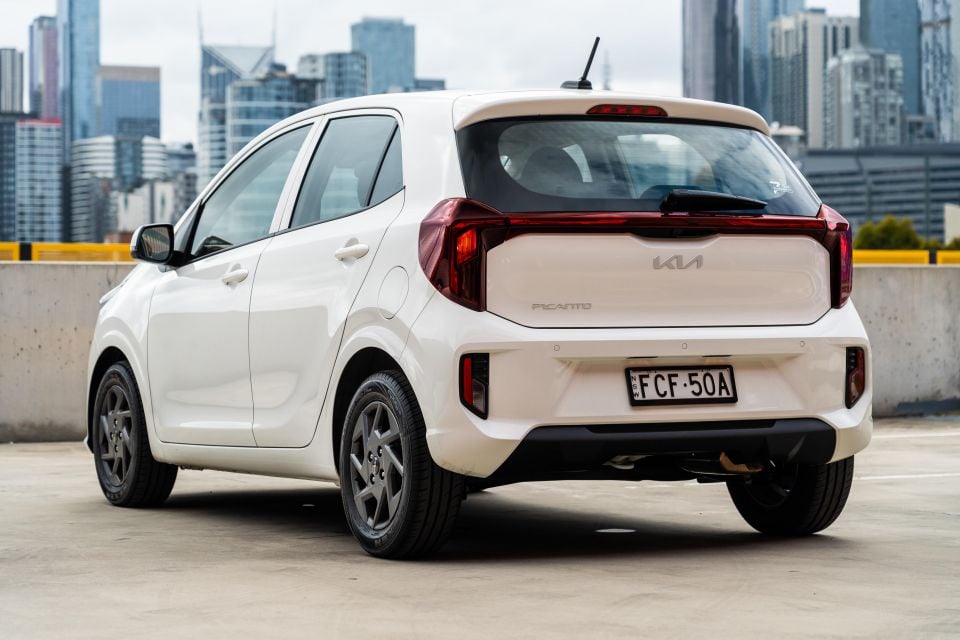
There are also alerts to warn you if you’re about to open your door into the path of another vehicle, and to notify you if the vehicle ahead is moving while you’re stopped.
The base Picanto Sport features 14-inch alloy wheels and automatic halogen headlights with automatic high-beam, as well as power-folding exterior mirrors, cruise control, power windows and remote keyless entry.
Inside, there’s an 8.0-inch touchscreen infotainment system with wireless Apple CarPlay and Android Auto, plus a leatherette-wrapped steering wheel and shifter.
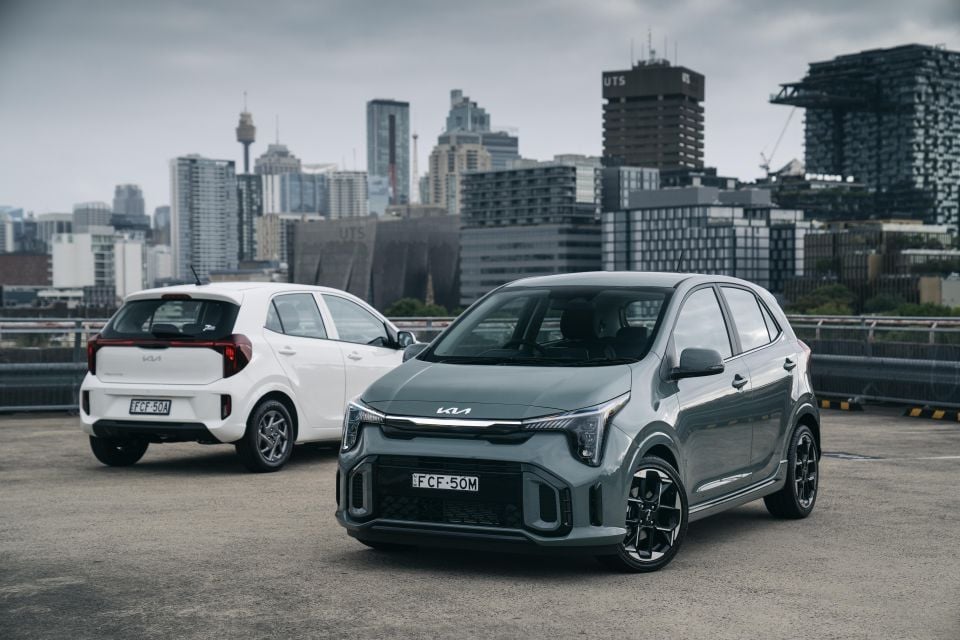
Stepping up to the GT-Line gets you larger 16-inch alloy wheels, LED headlights and leatherette upholstery, among other niceties.
The Picanto is backed by a seven-year, unlimited-kilometre warranty, and Kia offers seven years of capped-price servicing.
The first seven services, required every 12 months or 15,000km, are capped at $310, $506, $367, $537, $349, $630 and $370.
MORE: Buy a Kia Picanto MORE: 2024 Kia Picanto review
Price: $21,490 before on-roads
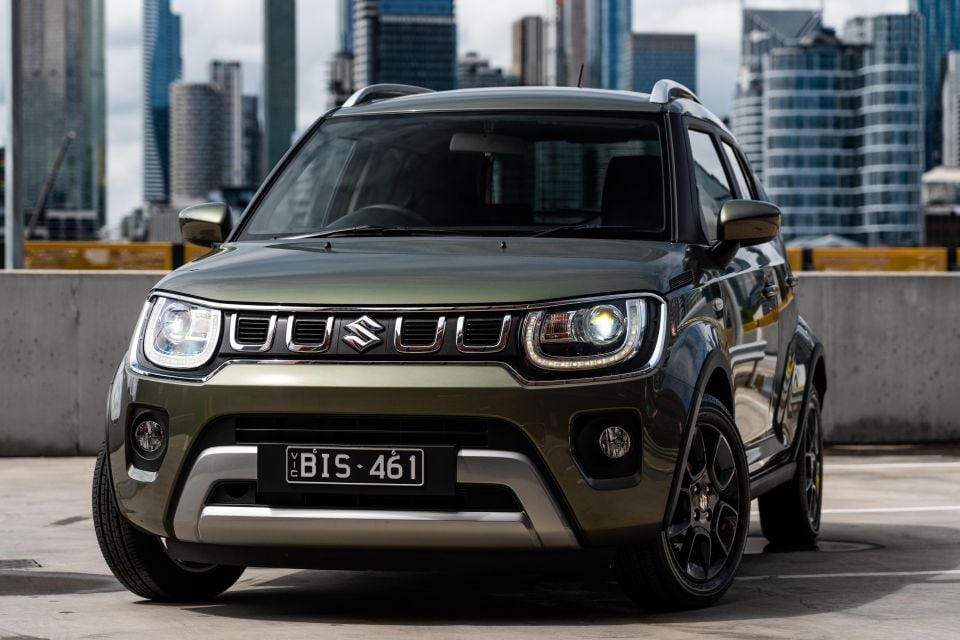
Small car specialist Suzuki’s cheapest model here is the quirky Ignis, a kind of tallboy hatch that’s marketed as an SUV but at just 3.7m long is close to a Picanto in size.
It’s powered by a naturally aspirated 1.2-litre four-cylinder engine with 66kW and 120Nm, mated with a five-speed manual; a continuously variable transmission adds an extra $1000 to the price of the base GL.
The Ignis uses 4.7L/100km on the combined cycle (4.9L/100km with the optional auto) and runs on 91 RON regular unleaded fuel.
The entry-level GL rides on 15-inch steel wheels with wheel covers, while inside there’s a leather-wrapped steering wheel with tilt adjustment, a height-adjustable driver’s seat, air-conditioning, a four-speaker sound system, a 7.0-inch touchscreen infotainment system,

There’s no autonomous emergency braking, but you get front, front-side and curtain airbags and a reversing camera.
Cruise control, power windows, and a rear wiper also feature as standard.
Suzuki backs the Ignis with a five-year, unlimited-kilometre warranty and offers five years of capped-price servicing.
The first five services are capped at $319, $429, $409, $449 and $349, with intervals of 12 months or 15,000km.
MORE: Buy a Suzuki Ignis MORE: 2023 Suzuki Ignis review
Price: $22,500 before on-roads
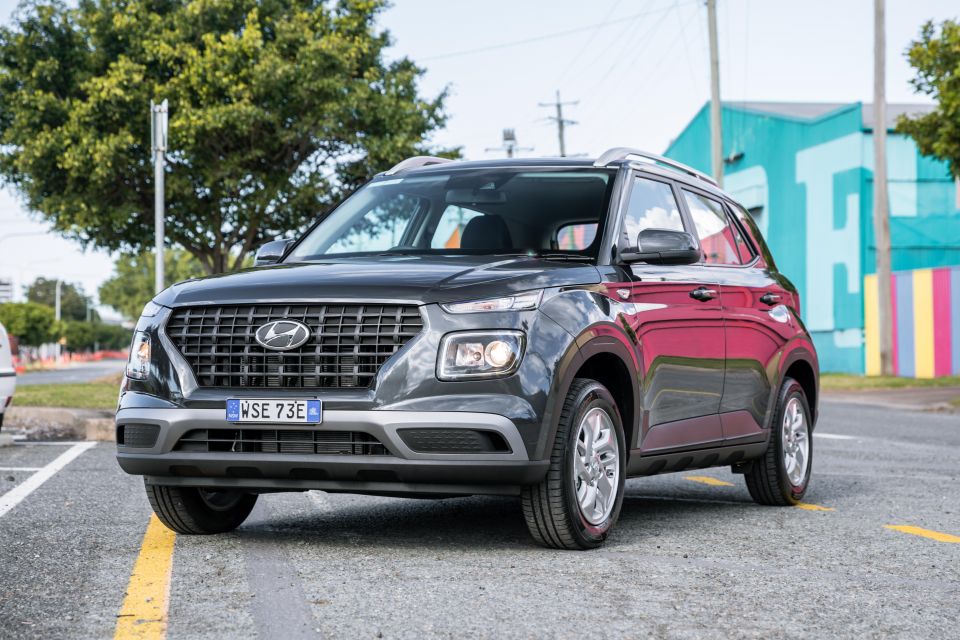
Hyundai sales really took off in Australia during the run of the second-generation Excel, which started at $13,990 drive-away. Adjusted for inflation, that figure works out to be $27,484, while Hyundai’s current entry-level model – based on a Queensland postcode – rings up at $25,490 drive-away.
Instead of a hatchback body style like the Excel or its Accent or Getz successors, the Hyundai Venue has a boxy body and is marketed as an SUV.
It’s front-wheel drive-only, though, and in Australia comes exclusively with a naturally aspirated 1.6-litre four-cylinder engine producing 90kW of power and 151Nm of torque.
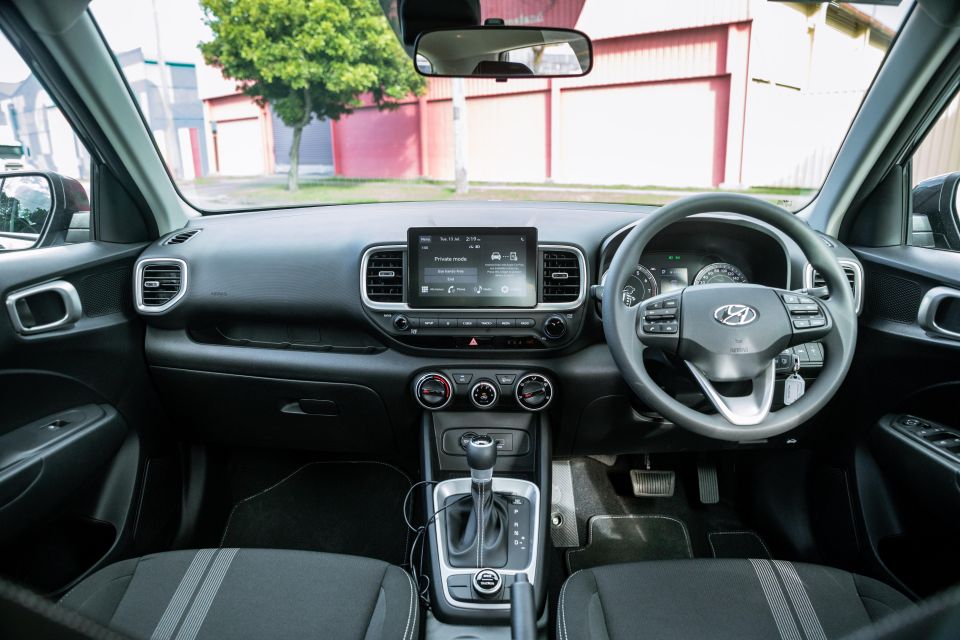
There are three trim levels, but only the base Venue offers a six-speed manual. You can, however, get a six-speed auto for an extra $2000.
The Venue uses 7.0L/100km on the combined cycle with the manual or 7.2L/100km with the auto, and runs on 91 RON regular unleaded fuel.
All Venues come standard with autonomous emergency braking with pedestrian detection, as well as lane-keep assist, driver attention warning, tyre pressure monitoring, and alerts to advise you the vehicle ahead is driving off and to check if you’ve left anybody in the back seat before locking the car.
There are also front, front-side and curtain airbags and a reversing camera.
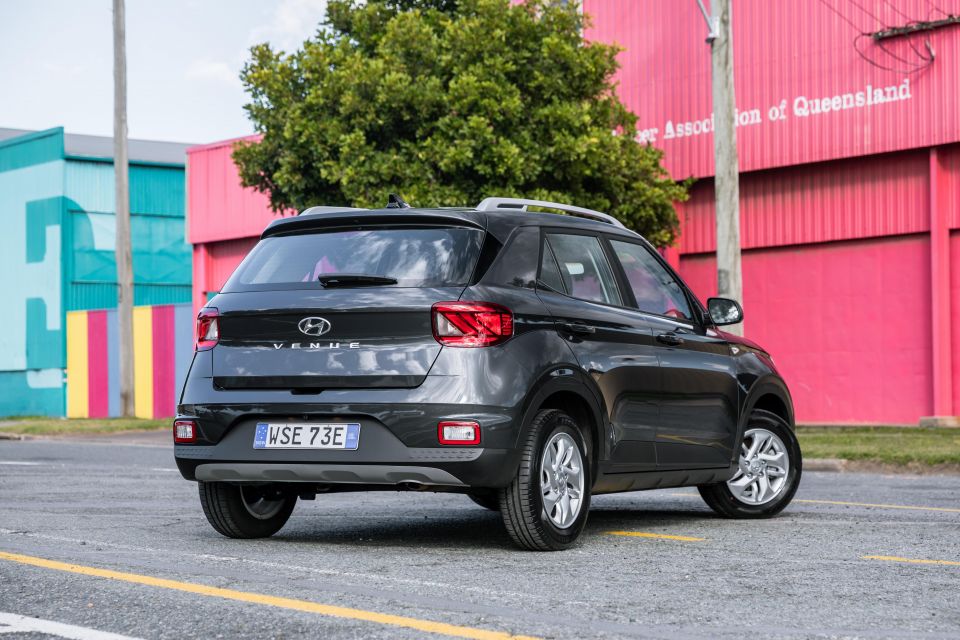
Also standard on the base Venue are automatic headlights with automatic high-beam, 15-inch alloy wheels, cruise control and remote central locking.
Inside, there’s an 8.0-inch touchscreen infotainment system with wireless Android Auto and Apple CarPlay, plus a wireless phone charger, four-speaker sound system, tilt and telescopic steering column adjustment, power windows and air-conditioning.
The Venue is backed by a five-year, unlimited-kilometre warranty, and Hyundai offers lifetime capped-price servicing. The first five services are capped at $299, $299, $395, $525 and $299.
MORE: Buy a Hyundai Venue MORE: 2023 Hyundai Venue review
Price: $22,870 before on-roads
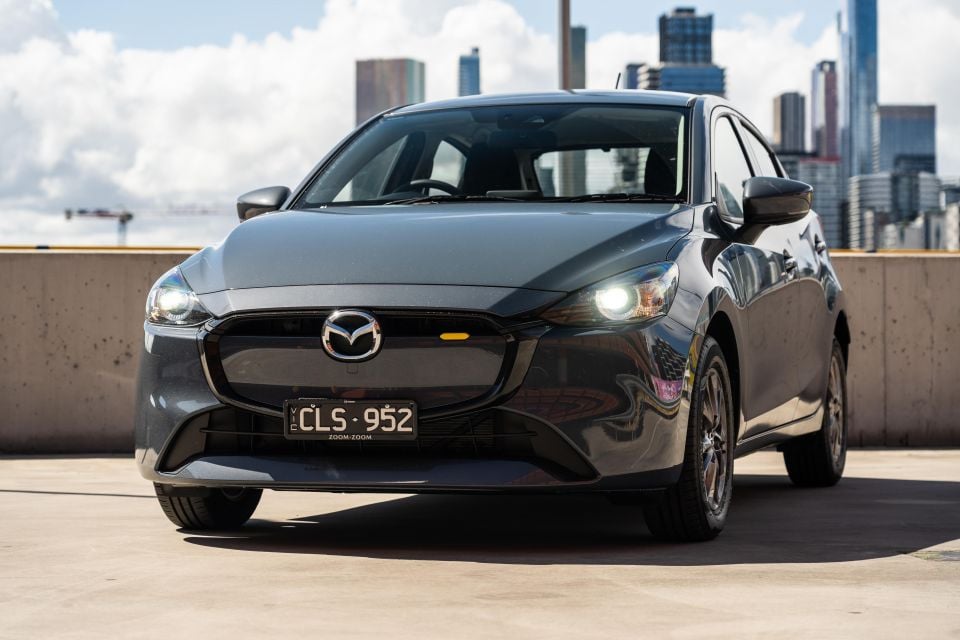
The Mazda 2 is the priciest of this quintet, but it has one of the more comprehensive suites of safety equipment.
Not only is there standard autonomous emergency braking, there’s also blind-spot monitoring, lane-keep assist, and rear cross-traffic alert.
Also unusual for this end of the market are standard automatic LED headlights, which make rural driving safer. Unlike the Picanto, however, the blind-spot and rear cross-traffic systems use alerts only, and don’t steer or brake the vehicle to get you out of strife.
These features are in addition to the obligatory reversing camera, rear parking sensors, and front, front-side and curtain airbags.
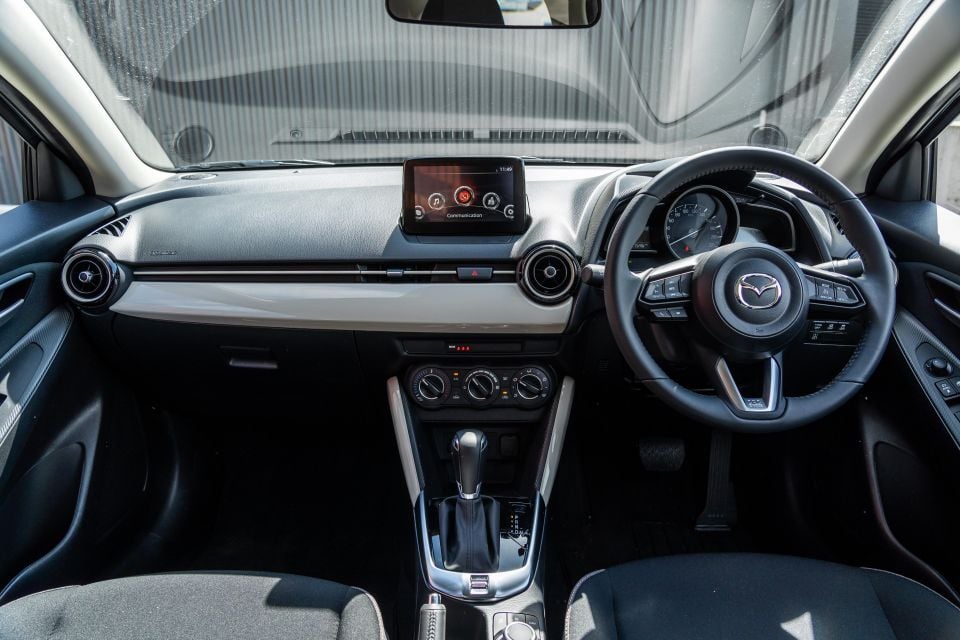
While the base G15 Pure grade is offered in either five-door hatch or four-door sedan body styles, you can only get the price-leader six-speed manual transmission in the hatch. The auto costs an extra $2000 if you don’t want to row your own gears.
Under the bonnet is a naturally aspirated 1.5-litre four-cylinder engine with 82kW and 144Nm (81kW and 142Nm in auto models), with an automatic stop/start system.
The manual uses a claimed 5.4L/100km on the combined cycle. That makes it slightly thirstier than the auto, which uses 5.0L/100km. All run on 91 RON regular unleaded fuel.
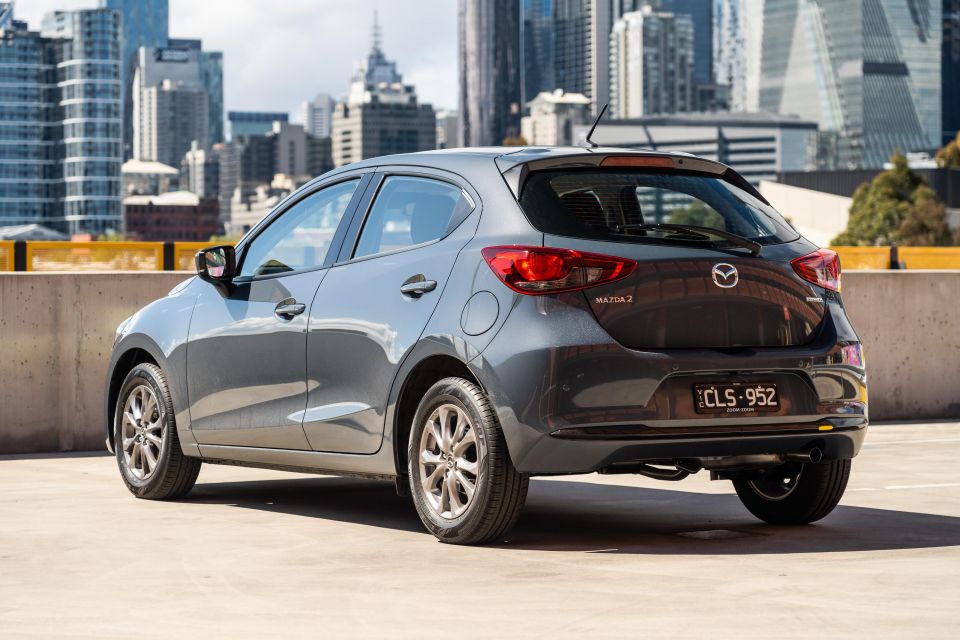
Standard equipment on the G15 Pure includes 15-inch alloy wheels, rain-sensing wipers, power-folding exterior mirrors, a leather-wrapped steering wheel and shifter, tilt and telescopic steering wheel adjustment, remote keyless entry, air-conditioning and power windows.
There’s a 7.0-inch infotainment screen with wireless Apple CarPlay and wired Android Auto, as well as DAB+ digital radio and six-speaker sound system.
The Mazda 2 is backed by a five-year, unlimited-kilometre warranty, and Mazda offers five years of capped-price servicing.
Intervals are every 12 months or 15,000km, and the first five services are capped at $334, $526, $396, $526 and $334.
MORE: Buy a Mazda 2 MORE: 2024 Mazda 2 G15 Pure review
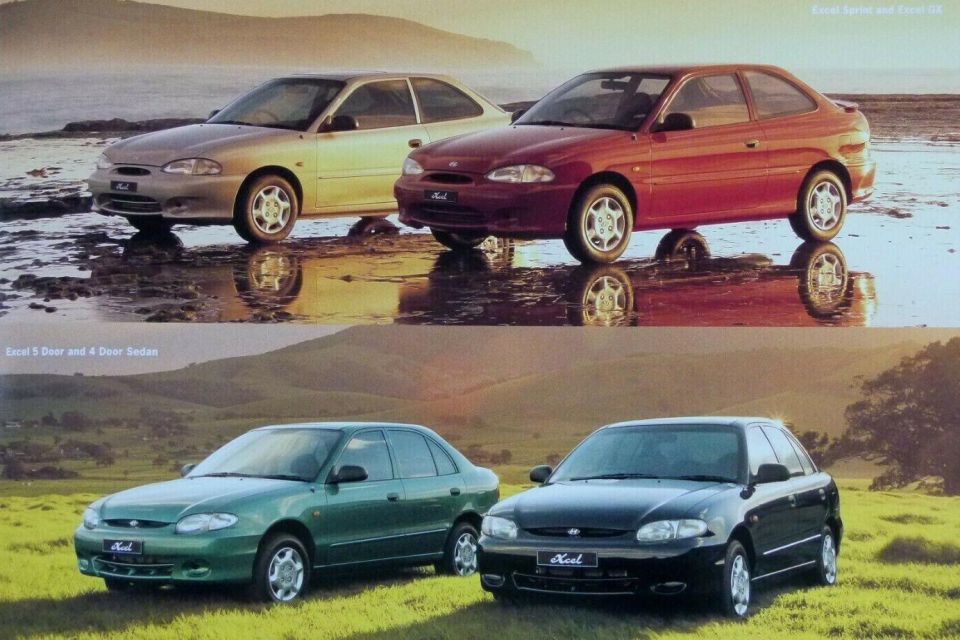
Rewind 25 years, and autonomous emergency braking wasn’t yet around in any cars in Australia, let alone mandated on new vehicle introductions.
Air-conditioning wasn’t standard on all new vehicles, while features like power windows and mirrors were still luxuries at the lowest end of the market. Even power steering was missing from some cheapies, and you’d need good luck finding a light car with cruise control.
Even airbags were rare among circa-$15,000 cars.
In 1999, it wasn’t a question of “does this sub-$20,000 car have Apple CarPlay?” but rather “does this have intermittent wipers?”
Here are the cheapest cars in Australia back in April 1999:
Price: $11,990 Price adjusted for inflation (2023):$23,555

Daihatsu’s lineup in the late 1990s was in flux. The Charade was on its way out, and would be axed in 2000… only for the name to reappear later on a smaller, cheaper model. The ancient Applause hatch, rugged Rocky and Feroza off-roaders, pint-sized Move, and Pyzar people mover were all killed by the end of the century.
The long-running Charade effectively made way for two vehicles: the smaller, cheaper Sirion in 1998, and the tallboy YRV in 2001.
The frog-faced Sirion was powered by a 1.0-litre three-cylinder engine with just 41kW of power and 88Nm of torque, mated with a five-speed manual or – for $1500 more – a four-speed automatic.
With a claimed 0-100km/h time of 17.7 seconds, it wasn’t quick.
For your meagre outlay though, you got metallic paint, power windows, power mirrors, central locking, dual airbags, a two-speaker sound system with a cassette player, and intermittent wipers. That was a surprisingly full feature list for something this cheap.
Air-conditioning was a $1335 option while anti-lock brakes were an extra $790.
The Sirion was backed by a three-year, 100,000km warranty.
Price: $12,990 drive-away Price adjusted for inflation: $25,519

The ancient Suzuki Swift was on its last legs in 1999. It had arrived in Australia a decade prior, and would finally be ditched for the quirky Ignis in 2000.
For some reason, only North America had received a replacement Swift – also known as the Geo/Chevrolet Metro and, in Canada, as the Pontiac Firefly – back in 1995. It used the same platform but featured entirely new styling, as well as standard dual airbags.
Markets like Europe, Japan and Australia stuck with the old 1989-vintage Swift which, by April 1999 was once again Suzuki’s cheapest model after it axed the $9990 Indian-built Alto a few months prior.
Under the bonnet was a naturally aspirated 1.3-litre four-cylinder engine with 50kW of power and 101Nm of torque, up 10kW and 29Nm on the defunct Alto’s 1.0-litre.
For your money, you got body-coloured bumpers, split/fold rear seats and a cassette player. Power steering was an option along with air-conditioning, and there were no airbags to be seen.
There was a special edition GP Encore offered around this period which was a bit less grim, featuring air-conditioning, alloy wheels, power steering and power windows for $12,385 before on-road costs.
All Suzukis featured a three-year, 60,000km warranty in 1999.
Price when new: $13,490 drive-away Price adjusted for inflation: $26,501
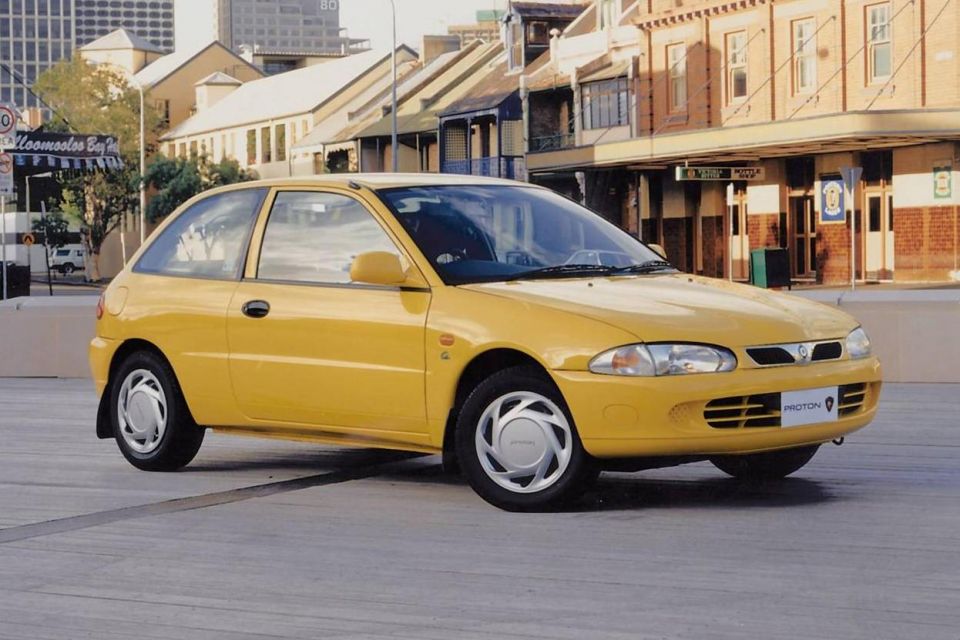
Proton was a brand that never really seemed to get any traction in Australia, whether it was selling reheated old Mitsubishis like the first Satria, Persona and M21, or in-house designs like the Gen.2.
Arriving here in 1995 with a restyled Lancer called the Wira, the Malaysian brand added a second model in 1997 called the Satria.
This was little more than a Malaysian-built version of the previous-generation Mitsubishi Colt/Mirage that had never been offered here, arriving shortly after that model’s successor was launched in Australia.
Unlike the Wira, styling was essentially unchanged from the Mitsubishi donor vehicle – hardly a bad thing, as the Colt still looked modern by 1997, and it’s not as though Australians had tired of seeing it on our roads.
It had the most generous warranty of any of the cars here at three years or unlimited kilometres, and came with standard air-conditioning, power steering, and a height-adjustable driver’s seat and steering wheel. It didn’t have any airbags, though – only Proton’s M21 coupe would offer one in 1999.
Under the bonnet was a naturally aspirated 1.5-litre four-cylinder engine with 66kW and 126Nm, mated with a five-speed manual; a four-speed auto was a $1000 option. The claimed 0-100km/h time was 13.6 seconds.
The Satria – which was also offered with a larger 1.6-litre and, later, in a hot 1.8-litre GTI model – was Proton’s most successful model in Australia. That’s not saying much as even in 1998, its best year, Proton sold 1920 examples, which saw it outsold by almost all its rivals bar a handful of Daihatsu and Suzuki models and the Volkswagen Polo.
There was a glut of vehicles under $15,000 – 14 different models and 17 variants in total – so we’ve limited this to vehicles priced at $13,990 drive-away in April 1999, of which there were still several.
Price when new: $13,990 drive-away Price adjusted for inflation: $27,484
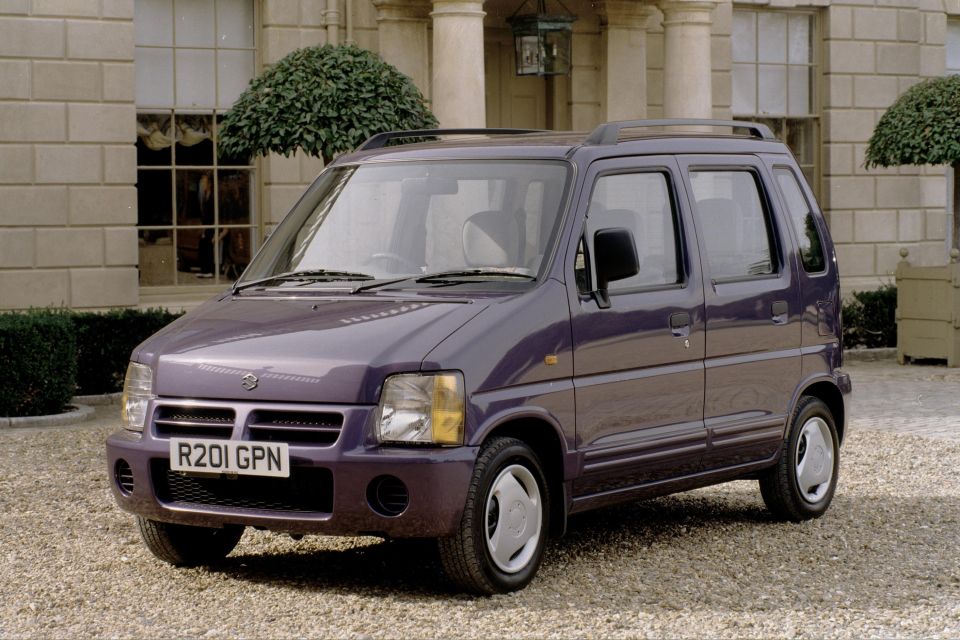
At a time where Toyota’s most affordable car is only just under the $30,000 mark, where Hyundai no longer sells a light hatch here, and Ford no longer sells any passenger cars beyond the Mustang, this quartet stands out.
Much as the Ignis is one of the cheapest cars on sale today, the Wagon R+ was another quirky, tallboy hatch/wagon that was one of the cheapest cars on sale in 1999, although it was in the process of being phased out by this point.
The Wagon R+ was a modified version of the Wagon R kei car for export markets. Gone was the 658cc engine required to meet Japanese kei regulations, replaced with a 1.0-litre naturally aspirated four-cylinder engine with 48kW and 81Nm. A five-speed manual was the only transmission.
It measured just 3410mm long, 1575mm wide but 1705mm tall on a 2335mm wheelbase, but this was still 115mm longer, 180mm wider and on a 75mm longer wheelbase than the Japanese-market Wagon R.
Standard equipment was decent, with a driver’s airbag, front power windows, split/fold rear seats and metallic paint. Alloy wheels and air-conditioning were optional.
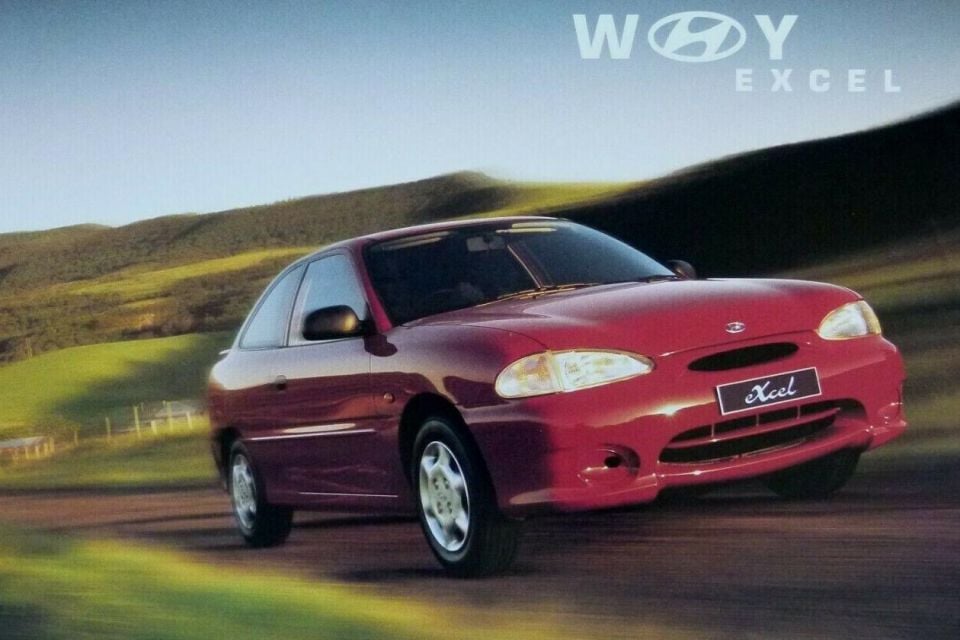
The Wagon R+ may have been tiny, but it was a huge flop here. Officially sold here for around two years, just 602 examples were sold – slightly less than even the also unpopular Daihatsu Move.
Far more orthodox were the other $13,990 drive-away cheapies: the Festiva, Excel, and Starlet.
The Excel was enormously popular in the 1990s, offering a little more space than many light cars plus a long warranty (five years or 130,000km).
The 1999 Excel Sprint also featured a gutsy 1.5-litre four producing 77kW and 137Nm, and by this point air-conditioning and power steering had been made standard though a driver’s airbag was optional.
Also standard were intermittent wipers, body-coloured bumpers, remote boot and fuel filler door releases, and a four-speaker sound system with a cassette player.

A five-speed manual was standard, with a four-speed auto costing an extra $1758.
The Excel was far and away the best-selling car in its segment, and in 1999 was the fourth best-selling vehicle overall in Australia.
Further down the sales charts were the Japanese Toyota Starlet and Korean Ford Festiva, both of which had a shorter three-year, 100,000km warranty and 1.3-litre four-cylinder engines.
The Festiva’s engine produced 47kW and 100Nm and was mated with a five-speed manual, though a more powerful 1.5-litre was available higher up in the range.
Power steering, a CD player, a remote hatch release, a rear wiper, and a four-speaker sound system were standard, with a driver’s airbag, air-conditioning and a three-speed auto transmission optional.
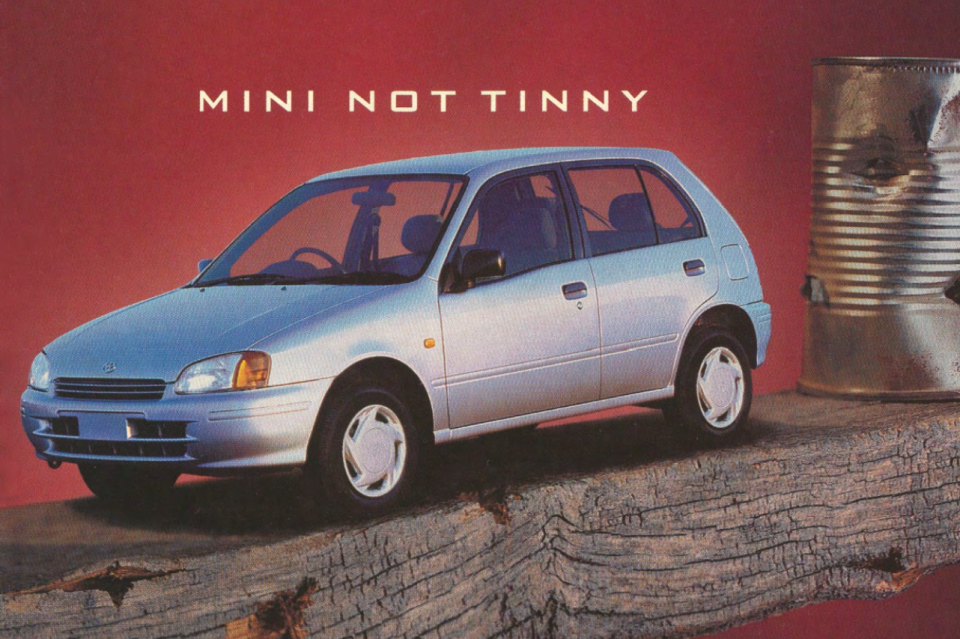
The Starlet’s 1.3-litre, the only engine offered in Toyota’s light hatch, produced 55kW and 112Nm and was mated with a five-speed manual.
A driver’s airbag was standard, with a passenger airbag, anti-lock brakes, power mirrors, central locking, power steering and a three-speed auto transmission among the options.
The Starlet was replaced in 1999 by the much more distinctive Echo, while the Festiva expired in 2000 and was replaced by the three-door-only Ka.
William Stopford is an automotive journalist with a passion for mainstream cars, automotive history and overseas auto markets.


Marton Pettendy
3 Hours Ago


Max Davies
3 Hours Ago


William Stopford
4 Hours Ago


James Wong
4 Hours Ago
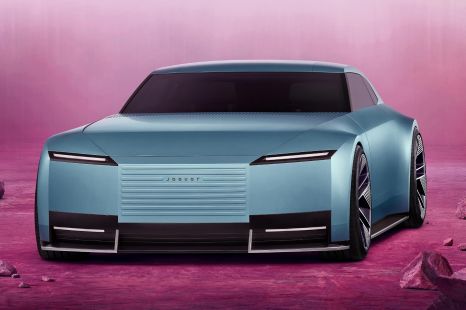

William Stopford
7 Hours Ago
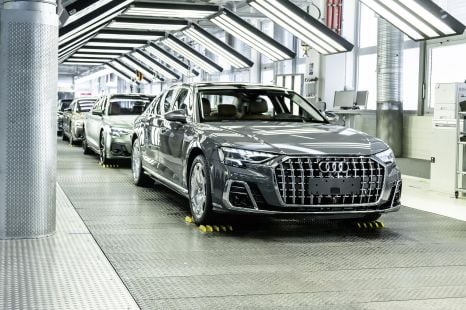

Derek Fung
9 Hours Ago